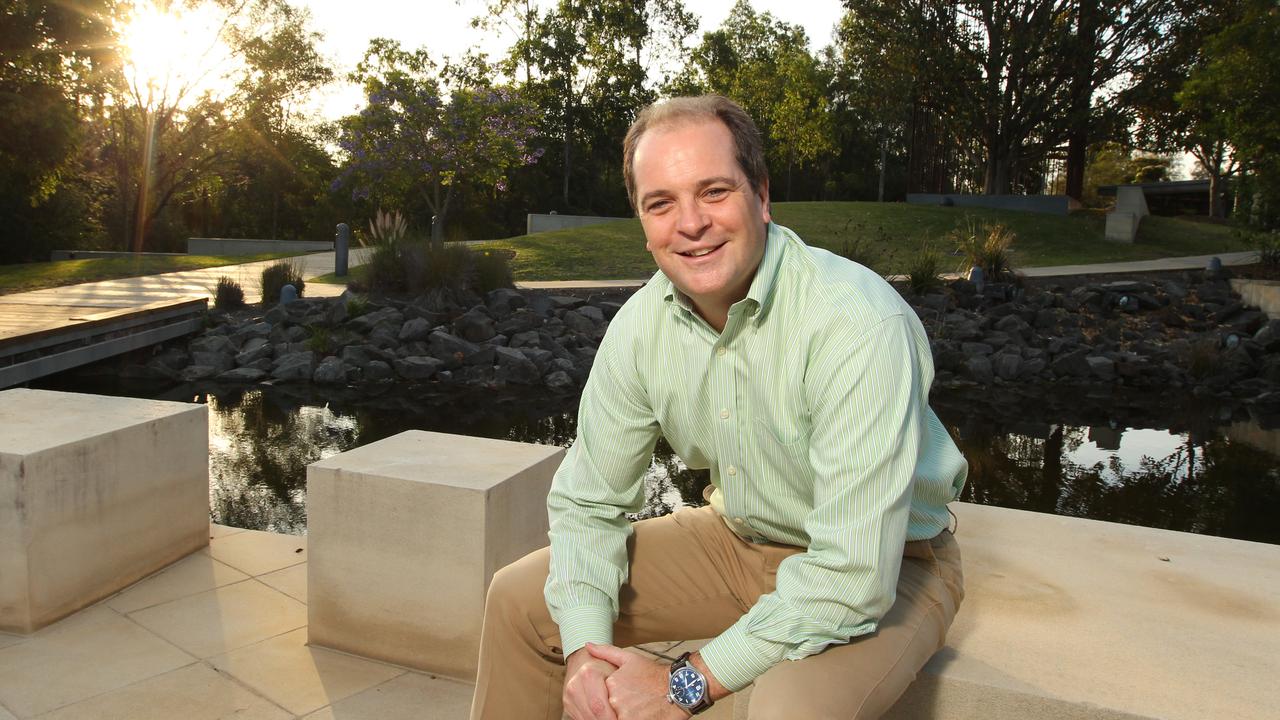Lessons as two CEOs prepare to exit: Long-term is how it’s done
Two bosses are stepping down in coming months and both will leave an undeniable mark, having reshaped their businesses dramatically.

Business
Don't miss out on the headlines from Business. Followed categories will be added to My News.
Two bosses are about to finish up in the coming weeks. Both run national challenger businesses from bases in regional Australia, and both are unique as they prepare to leave after decades with their respective companies.
The two have been working on the long-term vision for their organisations. They will leave an undeniable mark, having reshaped their businesses dramatically, particularly as technology has fundamentally changed how they operate.
And, both — Mark Fitzgibbon of health fund NIB and Marnie Baker of Bendigo Bank — believe their businesses are the cusp of something much bigger.
Fitzgibbon’s time has been about building his health fund out. He is set to finish up in early November after a remarkable 22 years in the role. He ranks as one of the longest-serving CEOs among ASX-listed companies.
His tenure includes steering the formerly sleepy mutual, which emerged more than seven decades ago from BHP’s Newcastle steel works, through to an ASX listing in 2007 and then through the Covid pandemic, when health was at the front line.

Fitzgibbon has driven NIB. He corporatised it, pushed it into New Zealand and made it a top four brand in Australia.
More recently, he has built out new revenue streams from adjacent markets, including travel insurance and international student health cover. He has staked out new ground as an NDIS service provider and more recently moved into the Honeysuckle head venture, which delivers digital and telephone-based chronic disease management and preventive health programs.
Fitzgibbon says he has taken a methodical approach to broaden the NIB proposition into a fully fledged health management company.
“I think not too far into the future, people would be surprised to learn that once upon a time, NIB was purely a private health insurance company,” he tells The Australian.
“The sense of financial security and connection to hospitals will always remain important, but there’ll be so much more to the membership of NIB. In fact, I might be a member without even having private insurance.”
Even today people are surprised to know that once upon a time, NIB was a little health fund deep in the bowels of BHP, he says. Back then it might have been hard to imagine the longer term future of the business.
“We’re doing more than imagining it. We’re about making investments and filling out the public-private partnership ecosystem as we like to call it.”

Fitzgibbon is ever the optimist about health and believes NIB will continue to have a strong proposition, delivering value across all parts of the health chain it chooses to operate in.
Digital channels now mean NIB is connecting with customers more than ever.
Its new telehealth services were used by 176,000 people last year. A 24-hour health symptoms line in the NIB app was used by more than 30,000 members last year. In New Zealand, NIB is piloting groundbreaking community health programs.
As we live longer and are able to treat chronic diseases, what’s not going to change is government’s “increasing inability to fund healthcare because of a rising dependency ratio of older people like me on younger taxpayers”, Fitzgibbon says.
“Add to that the burden of the aged care budget and NDIS budget. So, inevitably, as a society, we’re going to have to place greater reliance on private funding and delivery mechanisms”.
NIB is already starting to see some of this change the discussion around private health. His membership numbers are up 2.5 per cent, with growth coming in the face of tight household budgets and inflation. Fitzgibbon puts this down to worries about deep stresses on the public health system since the Covid pandemic.
“None of that is to guarantee us a future but we like to think, as a company, we’re on the right path to that future in understanding people are looking for a more holistic, integrated, seamless way to access their healthcare.”
NIB’s Australian operations boss Ed Close was recently named to take charge as chief executive. Given such a dominant long-term CEO is retiring, NIB faces high risk in the transfer, even with an internal succession.
Since listing, NIB has grown up quickly. And, as the first health insurer to trade on the ASX, it wasn’t all easy. It has more than doubled Australian policyholders to more than 700,000 from 320,000 on listing. It had a market value of more than $440m; today it trades at nearly $3.4bn. At the time of its ASX debut it was generating around $32m in annual net profit; on Monday it delivered a full-year profit of $181m.
The choppy waters continued for Fitzgibbon as he delivered his last set of numbers. NIB’s shares were whacked more than 17 per cent on worrying signs its customers were claiming at a rate outpacing the broader industry.
This remains the biggest challenge for incoming boss Close: to ensure claims inflation can be brought under control, as well as NIB’s own cost structure.
Fitzgibbon says the market is adjusting to the claims inflation coming out of the Covid pandemic. At the same time, some of NIB’s adjacent businesses haven’t rebounded as quickly as he’d like. But, they are coming back and NIB is on the right path, he says.
NIB is also pushing further into its digital-first strategy for customers. So, too, the prospect of AI and automation lends itself to increasing speed and the prospect of self service for customers.
Bendigo’s big build
Further south, Bendigo’s Marnie Baker finishes up this Friday after more than six years as chief executive and 35 years with the bank. It’s a big week for Baker as she celebrated her birthday on the same day as she signed off on her final set of accounts.
Baker’s tenure has taken a different focus. From the moment she took charge, it has been a about an internal agenda over growth. The Bendigo she inherited was already big and spread across many different businesses. This means Baker has essentially been rebuilding Bendigo to make it more efficient, turning the regional lender into a challenger for the big banks.
Any bank executive will tell you, it’s hard, expensive work rewiring a bank, and the rewards generally take years to be seen. The market has little patience for long-term programs and that’s why it has rarely been done in a wholesale way.
Baker pushed ahead. Her efforts have been around reducing complexity, slashing the number of brands and even getting out of some business lines. She has closed down legacy technology and, yes, even some branches.

Her rebuild has also involved spending big on technology — where it counts. This includes building a digital platform to deliver a fully automated mortgage while putting Bendigo right in the game among mortgage brokers.
She hands over to Bendigo’s retail banking boss and one-time chief financial officer Richard Fennell next week, with the full knowledge the benefits — such as revenue growth and lower costs, a longtime Bendigo bugbear — will eventually flow through to her successor.
Baker admits Bendigo still has some way to go to hit its stride as a “capable challenger” but is well advanced.
“We needed to get our house in order and that’s what the transformation program has been all about,” she says.
Baker signed off on a result delivering a 2.6 per cent drop in headline cash earnings to $562m. Encouragingly, the critical net interest margin increased by 13 points through the half, helped by low deposit costs, and the bank now has scale, with more than 2.5 million customers.

The one to watch for Bendigo is its Up digital bank, aimed at those in their late teens and early 20s, which is outpacing the growth of digital deposits of the flagship Bendigo brand.
It’s still early days but Up has signed up more than 920,000 customers in just over two years, marking rapid growth. It has $2.1bn in deposits, posting growth of 37 per cent.
However, the average deposit balance is low. Baker says it’s to be expected given Up’s customers are younger and it is not yet a full service bank. The customers are loyal and will grow with the bank, she adds.
While the market might be hardwired for short-term results, Baker says Bendigo’s heritage goes back 166 years and this means it has the confidence to develop a long-term vision.
From Bendigo’s decades-old community bank model (which is a now Bendigo’s biggest source of low-cost deposits) to its investments in the new Up business, Bendigo is prepared to follow a different model to grow.
“We do take absolutely a long-term view, and sometimes that has hurt us, because the market itself is looking in the short term,” Baker says.
“But if we stick to our guns, hopefully we’ll show you with action that these were the right longer-term decisions”
No longer is Baker talking about rebuilding the back end by moving banking systems on to the cloud. Rather, the conversation is around the customer-facing services such as fast loans and digital banking.
“We are at a really good point in time now,” she says.
When pressed about her exit the chief executive says she will miss the teamwork and Bendigo’s “can do” attitude.
“I put a big challenge up with a really ambitious agenda six years ago. The organisation just grabbed hold of that, and it’s really worked really hard over the last six years to achieve what we have achieved, and I’m extremely proud of that.”
Originally published as Lessons as two CEOs prepare to exit: Long-term is how it’s done



